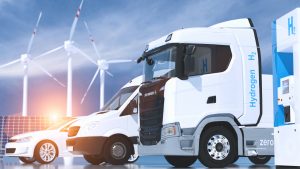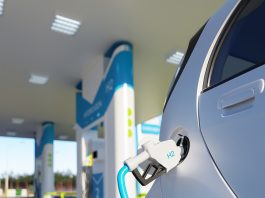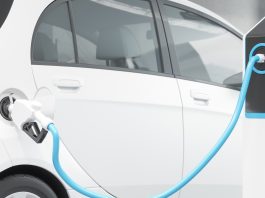Amer Gaffar, Director of the Manchester Fuel Cell Innovation Centre, spoke to Managing Editor Lisa Carnwell, explaining the challenges involved in creating a low-carbon economy.
In November 2020, the UK Government announced their Ten Point Plan for a Green Industrial Revolution, mobilising £12bn of investment to create and support 250,000 ‘green’ jobs. As part of their commitment, the government announced a new hydrogen production target of 5GW by 2030 along with £240m of a total £500m fund earmarked for production facilities. The fund expects to encourage a further £42bn of private investment by 2030 across energy, buildings, transport, innovation and the natural environment.
The funding implies the government’s recognition that hydrogen will play a critical role in emissions reductions, but how can we ensure the investment in networks, storage, and distribution is deliverable?
Lisa Carnwell, Managing Editor at The Innovation Platform, spoke to Amer Gaffar, Director of the Manchester Fuel Cell Innovation Centre (MFCIC) at Manchester Metropolitan University (Manchester Met), to understand how the region is spearheading the approach to a low-carbon economy.
What is the concept behind the MFCIC, and how does it tie into Greater Manchester’s overall low-carbon economy ambition?
The concept for the MFCIC has one driving ambition — achieving net zero, and that involves examining how we construct and heat our buildings, how we can ditch the use of fossil fuels, and how we achieve energy efficiency through technology. Fuel cells and batteries are options, and it is about how each intervention contributes to that net zero ambition.
Our journey began in 2013 when the Manchester Met helped launch the Greater Manchester Hydrogen Partnership, ultimately highlighting the need for the current centre. The partnership aimed to develop a network of hydrogen fuel cell stakeholders that could bring together knowledge and skills to improve Greater Manchester’s capacity to address the challenges of grid demand, energy security, and the ability to create a low-carbon economy.
In August 2018, the MFCIC officially opened due to work we completed with our stakeholders, which included Greater Manchester Combined Authority (GMCA), to develop what the hydrogen vision for our region would look like. We built that vision on one of the greatest strengths of our landlocked region, and that is our science asset base.
Manchester Met has always been influential in materials chemistry and surface engineering and recognised that hydrogen fuel cells would play a significant role in our future economy. We developed a vision for what the MFCIC could effectively be and how we would drive that vision, and that is through the businesses that we have in the region.
What sort of businesses do you support, what does that support involve, and what opportunities does the MFCIC provide?
We have already worked with many SME businesses concerned with low-carbon environmental goods, but we have also helped support many industrial companies. By working across that complete spectrum, we provide them with the opportunity to engage with the £3m worth of equipment at our centre, which businesses can use to develop ideas, products, and innovations.
We also then support our local and national policymakers. We have written the Greater Manchester Hydrogen and Fuel Cell Strategy 2021-2025, which is being adopted, and outlines the ideas we should take forward in terms of the innovations that we are working on. Some of those ideas are around replacing the public sector fleet and heavy goods vehicles with hydrogen and using hydrogen as a replacement for the gas networks.

We provide an opportunity to create and develop green hydrogen at scale in the region. We have recently signed a collaboration agreement with Electricity Northwest, Carlton Power, Cadent Gas, Trafford Council, and Greater Manchester Combined Authority because, by 2023, we want to be able to generate green hydrogen in Greater Manchester.
We will support projects across the region for several end-users to demystify this technology, but we can also examine national policy and are pleased to see the release of the UK Hydrogen Strategy.
The strategy suggests government will build on our successful hydrogen research and innovation to date to reduce costs, address risks and provide safety and technical assurance of technologies at commercial readiness. This means the MFCIC can work with many more employers to create dedicated skills pathways and support more regional infrastructure projects whilst constantly growing the supply chain of businesses in the sector through engagement with domestic and international stakeholders (inward investment into the region).
Why are skills and people development so crucial in the efforts towards an energy transition?
We want to be world leaders in this technology, but we need to develop people alongside it. If we do not establish the people alongside the innovation, we will either buy in that resource or import or export the technology that we want to be able to deploy here. It is not just about hydrogen, it is about what will it take for us to get to net zero, so the whole range of technologies, like fuel cells, wind, solar PV, and batteries, should all work together to create that energy transition. We will get to net zero within that energy transition, but ultimately, it is down to how we develop those people to support it.
It is crucial for the industry to work with schools, colleges, and universities, to co-develop the specific courses required for the net zero economies to grow. Consider the people who are in employment right now and those we can retrain. In 2030, there will be a ban on buying petrol and diesel vehicles, but what about those currently working in the sector?
When the hydrogen fuel cell market properly matures, the schoolchildren of today will probably make most of the difference, but that difference needs to be made now. That tells me we should engage with the Department for Education to understand how we will teach a net zero curriculum. We then must work up the value chain, from schools to FE colleges, universities, and industrial employers or smaller businesses.
It is essential for academic institutions to lead the pathway as a collaborative. We are leading the skills pathway for Net Zero North West because it makes sense. The future course material for an electrical engineer, for example, will have to include an understanding of net zero technologies, or a gas engineer will need to understand that the input gas does not have to be methane or natural gas, but hydrogen.
We have also developed a project for high schools. HySchools has a set of resources used by thousands of teachers and students weekly. They are taught about hydrogen fuel cells (all extracurricular) from 11 different topics, including applications, history, and business cases.
As COP26 approaches, one of its significant ambitions should be the role of net zero skills and how we ensure the future workforce is catered for in this market.
Considering the MFCIC’s ambition to reach net zero, how can you achieve that?
Unfortunately, we are in a climate change environment, with poor air quality existing in many parts of the UK. The situation is improving with clean air zones, and the technology shift allows us to clean up the air, which will help save lives. We talk about hydrogen technology being promoted now because there is a substantial economic stimulus behind it globally. Net zero is high on the agenda of organisations, and there is the political will of the country to match, which has not been there before.
For me, that is why this innovation space is so prominent because it is solving real world problems. Batteries, fuel cells, and hydrogen solutions can solve the fundamental issue of climate change and the genuine issue of clean air.
We want these solutions to be able to solve climate change through reduced emissions.

For instance, the transportation sector in the UK currently accounts for around 30% of carbon dioxide emissions, and the most significant portion of that is from road transport. Most of our homes are powered by gas which accounts for another 40% of emissions.
Climate change is not just a government problem; it is a problem for us all individually. I believe the push from the research and design sector to help support some of the technology innovations will help to realise our ambitions. Improving the efficiencies of fuel cells and improving the way hydrogen is made through electrolysers in innovative ways will support that ambition.
For the UK, in the next 12 to 24 months, there is a range of strategies and policies that have finance attached to them, including the long-awaited UK Hydrogen Strategy. These strategies finally give people and businesses the security they need to make investment decisions.
As stated in the UK Hydrogen Strategy, government investment in hydrogen to de-risk early projects could unlock over £4bn of private sector co-investment up to 2030. Our ambition also sets us on a promising pathway post-2030. For the MFCIC, this means that many more businesses will now engage in R&D projects, finally recognising the backing shown by the government for the sector within the hydrogen theme, providing an excellent opportunity for the centre’s ambitions.
How we achieve net zero is a significant challenge and one which involves a change in our behaviour. This is dictated by policy shifts such as the ban on buying petrol and diesel vehicles by 2030. That means there is a massive opportunity for the innovation sector to work with multiple stakeholders, from vehicle manufacturers to local policymakers through to planners.
As a region, Manchester has the ambition to be carbon neutral by 2038. An excellent example of this collective ambition is with the Greater Manchester Energy Innovation Agency, led by Greater Manchester Combined Authority (GMCA), Bruntwood, The Growth Company, HItachi EU, The University of Manchester, Manchester Met, University of Salford, and Scottish and Southern Energy Enterprise. The agency is looking at opportunities to deliver on those 2038 ambitions from electrifying our transport system, homes, and businesses. Combining our leading research base with industry and support from GMCA will result in Greater Manchester attracting organisations to invest in the region even more.
This will only work if everyone creates a shared plan together, and that shared agenda has to involve the technology, the policy, and the skills. It also must include developing the necessary infrastructure.
If we are serious about net zero, it requires batteries and fuel cells and the ability to link up all the different hydrogen projects in the UK. And that is critical because that accelerates fuel cell and battery deployment.
Transport decarbonisation is a crucial element to emissions reductions, but what is the role of hydrogen and batteries in decarbonising this sector?
Transport decarbonisation essentially means moving towards the electrification of vehicles. The passenger vehicle market are heavy emitters, but fleet operations, public transport, and HGVs are also included. The only effective way to decarbonise the whole system is if we generate that electricity through renewables.
One challenge around using hydrogen is the infrastructure, which is in its infancy in the UK. There are only a handful of refuelling stations, yet we need them to be almost as common as we do for petrol or diesel.
Supported by the UK Government, the Faraday Battery Challenge is a prime example of battery decarbonisation efforts with around £250m investment with a range of stakeholders committed to advance this technology further. New gigawatt factories are being developed in the UK; in July 2021, Nissan Motor Co announced it would build a £1bn giant battery plant in Sunderland to power 100,000 vehicles a year. That is a great thing to happen for the UK economy because it shows that we can recover from the pandemic for one and recover in a greener and sustainable way.
For the role of hydrogen, we need to recognise where fuel cells are in that technology readiness level. We do not make fuel cells from scratch in our facility; what we do is improve the efficiency of fuel cells and try to improve capital costs.
One example of improving the capital cost is by researching how we can remove or replace the platinum content with graphene, which makes fuel cells inherently expensive. We are also exploring different materials that stop the corrosion of the bipolar plates, the plates that actively hold the fuel cells together. And even when we prove those efficiencies, it is about new ways of manufacturing and designing that will improve the efficiencies and subsequently drive down the cost.
A fuel cell electric vehicle still has a tiny battery. But what displaces the battery is a fuel cell. As long as that fuel cell has a supply of fuel, which will be typically hydrogen, you can achieve 300-400 plus miles, and the only by-product is water.
Taxation is an issue we have not covered. Right now, there is no tax element when charging an EV at home. With hydrogen, especially low-carbon hydrogen, I would like to think that it will be taxed less. We recognise that something will need to replace the billions the UK Government receives from petrol and diesel taxation, but we hope that users of EVs will be taxed less overall.

What are the differences between using lithium-ion batteries and hydrogen fuel cells, and will there be an equal demand?
A fuel cell vehicle is an electrochemical device that combines hydrogen and oxygen to generate electricity, with heat and water as the only waste products. The electricity can directly power the electric motor in the vehicle, or it could effectively charge the battery, providing a potential mixture of the technologies. The battery-electric vehicle could be the dominant powertrain, and the fuel cell could provide some range extension. Many global manufacturers are developing fuel cell powertrains, and the commercially available ones are from manufacturers like Honda, Toyota, and Hyundai. Those vehicles are great from the innovation perspective, but we need that refuelling capability for the UK cities to take advantage of them.
Fuel cell vehicles lend themselves better to vehicles of scale because there is no requirement to increase the size of the battery to improve the range; it is just the size of the tank that increases.
Those adopting EVs are embarking on a shift change in their behaviour as they refuel that vehicle differently from a diesel or petrol-powered one; if there is a rapid charger available, you may still have to wait an hour and a half to charge it. That is down to factors such as ensuring the accessible infrastructure is available. For everyday use, if the infrastructure is there, electric vehicles make a lot of sense.
Underpinning all of the technology should be smart infrastructure that could inform users of the potential right time to charge a vehicle at home, as it might be cheaper off-peak, for example. From a hydrogen perspective, smart infrastructure could tell us when the ideal time is to run the electrolyser, as it might have other benefits like balancing the electrical grid across the region.
Fuel cell and battery technologies are gaining momentum worldwide as key drivers in achieving a carbon neutral future, but what will be the greatest challenge in scaling up production?
Most of the hydrogen produced in the UK comes from non-renewable sources, whether that be from Steam Methane Reforming (SMR) or industrial processes. That is great for industrial processes, but it does not entirely solve the UK low-carbon hydrogen requirement.
There are two types of low-carbon hydrogen; green and blue. Green hydrogen is entirely generated by renewables, and blue hydrogen is created when the natural gas is split into hydrogen and CO2 by SMR, for instance. The carbon is captured and stored, providing a low-carbon intensity.
Hydrogen projects are gaining momentum, such as the low-carbon hydrogen hub at the Trafford Low Carbon Energy Park. However, much of this activity is contingent on the political will of the country. Once policies are in place to support hydrogen, the investment decisions and increased roll-out should naturally follow, from an increase in fleet operators to those looking to use hydrogen in their heat networks.
One critical factor in developing hydrogen fuel is ensuring that businesses can develop their innovation and the technology readiness level. We talk about gigawatt factories for batteries, but we need innovation spaces where companies can plug and play the technology they are developing into infrastructure. That, for me, is a missing part.
For instance, if we can ensure that green hydrogen is at a price point where there is parity to diesel, we will have solved the puzzle. The UK has a real opportunity to build an entire economy and narrative around fuel cells, hydrogen and batteries.
The MFCIC has one of the best-specified research and design labs in hydrogen fuel cells in the region across early stage technology readiness levels (TRL). The missing part of the UK journey to become a world leader is an acceleration in demand driven by industry and smaller businesses. The UK needs to be able to accelerate the TRL of products. That means that they need to go through that period where they test and deploy at scale.
Therefore, our focus and vision for the future is to create new specialist facilities and expertise to support the UK and international supply chain to deploy and test net zero technology through higher stage TRL (between four and seven) and support our partners to take their products to market.
Amer Gaffar
Director
Manchester Fuel Cell Innovation Centre
Manchester Met
a.gaffar@mmu.ac.uk
Tweet @MFCIC
www.mmu.ac.uk/fuelcell
Please note, this article will also appear in the seventh edition of our quarterly publication.









